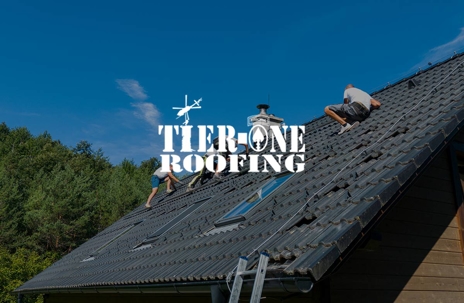The Wind Wasn’t the Problem—Your Roof Already Was
When Oklahoma winds tear shingles off a roof or rip flashing from your chimney, most homeowners blame the storm. But wind isn’t always the real problem. In our experience, it’s the roof that failed first.
At Tier-One Roofing, we inspect storm-damaged homes every week. And more often than not, the damage we see isn’t caused purely by the wind—it’s what the wind exposed: nails that were driven wrong, flashing that was never sealed, starter shingles that were skipped altogether.
And when that kind of poor workmanship meets 60+ mph gusts, the results aren’t just unfortunate—they’re expensive.
Let’s talk about why your roof may have been doomed before the storm ever hit, how to tell if yours is vulnerable, and what to do right now to protect your home before the next big system rolls through.
The Most Common Pre-Storm Problems We See
We’re not guessing. We’re on rooftops every day. And we can tell you—wind isn’t the root cause of most catastrophic roof failures in Oklahoma.
Here are the weak points we see over and over again:
Improper nailing (too few nails, or placed in the wrong area of the shingle)
No starter strip (which helps lock down the edge shingles against uplift)
Cheap or low-quality shingles not rated for Oklahoma wind speeds
Overdriven nails that compromise shingle hold
Poor attic ventilation causing warping or buckling
Flashing that wasn’t sealed properly or installed to code
Any one of these is a time bomb. Combined? They guarantee failure when wind shows up.
That’s why we tell homeowners: it’s not about the wind, it’s about what the wind has to work with.
How Poor Installations Become Expensive Storm Claims
Here’s how it usually plays out:
A storm rolls through.
Shingles fly off, exposing the decking underneath.
The homeowner calls insurance and files a claim.
The insurance adjuster climbs up and says: “Looks like wind damage, but… we also see install issues.”
That last part is the catch.
If your insurer determines the damage was made worse—or even caused—by faulty installation, they may reduce or deny your claim.
We’ve seen payouts cut in half or denied entirely just because the original roofer skipped a few critical steps.
You shouldn’t have to pay for someone else’s laziness. But that’s exactly what happens when poor workmanship goes undetected.
The Truth About Oklahoma Wind and Building Code
Oklahoma isn’t just “kind of windy.” In fact, according to the National Weather Service, Oklahoma averages more than 50 days per year of winds over 40 mph—and multiple days with gusts exceeding 60–70 mph.
Our building codes reflect this. Shingles here should be rated to withstand at least 110 mph winds. Fasteners need to meet specific depth and pattern requirements. Flashing needs to be secure against lateral movement.
Yet we see roofs across Tulsa and the surrounding areas that clearly weren’t built for this climate.
That’s why Tier-One Roofing never uses builder-grade materials or shortcuts. We install to exceed code—not just meet it.
Because in this state, code minimum isn’t good enough. It has to hold when the sky turns green.
How to Know If Your Roof Is at Risk
If you’re not a roofer, it’s tough to tell whether your roof is ready for the next storm. That’s why we offer free inspections to Oklahoma homeowners.
But here are some warning signs you can spot yourself:
Shingles curling or lifting at the edges
Black streaks or discoloration (sign of water intrusion)
Granules piling up in your gutters
Visible nail pops or blisters
Shingles missing at the roof edge (a telltale sign of no starter strip)
If you see any of this—or even if you don’t but your roof is over 7 years old—get a professional to take a look.
Tier-One Roofing will inspect your roof free of charge and give you a full report.
We’ll show you what looks good, what’s borderline, and what’s a real concern. No scare tactics. Just facts.
What to Do If Your Roof Fails in a Storm
Let’s say the worst happens. Wind tears off part of your roof and you’re exposed.
Here’s your move:
Call Tier-One Roofing immediately.
We’ll tarp the damage to stop further water intrusion.
We’ll inspect the failure and document everything.
We’ll help you navigate the insurance process and explain what went wrong—and why it’s covered.
Our goal is to make sure you don’t pay the price for someone else’s corner-cutting.
And if your current roof is a problem waiting to happen? We’ll help you replace it the right way—backed by the strongest materials, methods, and warranties in the region.
Why Tier-One Roofing Is Different
We’re veteran-owned. That’s not just a phrase—it shapes how we operate.
We believe in:
Precision over production
Accountability from start to finish
Clear communication with every homeowner we serve
Our roofs are built like it’s our family underneath. Because shortcuts aren’t just unethical—they’re dangerous.
We’ve earned the trust of hundreds of homeowners across Oklahoma. Not by selling. By showing up, doing the work right, and standing behind it.
When storms hit, our phones ring off the hook. And we answer every single one.
Don’t Wait for the Wind to Prove the Point
If you’re not 100% sure your roof was installed to stand up to Oklahoma wind, you have two choices:
Wait and hope
Or get ahead of it and know
Tier-One Roofing offers free, no-pressure roof assessments across Tulsa and surrounding areas.
We’ll inspect your roof, explain what’s going on, and if repairs or replacement are needed—we’ll shoot you straight.
No scare tactics. No sales gimmicks. Just a roof that holds.
Call Tier-One Roofing today.
Because the wind isn’t the real threat.
Weak work is.

